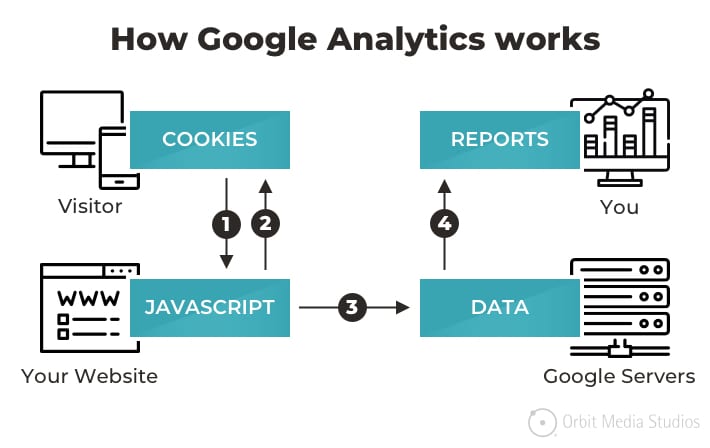Master Web Site Insights With Accurate Google Analytics Tracking Code
The reliable application of Google Analytics rests on the exact execution of its tracking code, a fundamental action frequently neglected by site proprietors. This apparently easy JavaScript bit, when appropriately positioned, ends up being the backbone of data collection, offering understandings right into individual actions and internet site efficiency. Nonetheless, difficulties can occur during arrangement, possibly skewing the information and bring about misinformed decisions. Understanding these complexities is vital for maximizing the benefits of analytics. What are the usual challenges that could weaken your monitoring efforts, and just how can you make sure accuracy in your method?
Understanding Google Analytics Basics
Google Analytics is an essential tool for website proprietors and online marketers, supplying vital understandings right into user habits and web site efficiency. At its core, Google Analytics accumulates information concerning site visitors to an internet site, permitting users to examine metrics such as web traffic resources, customer involvement, and conversion prices. Recognizing these principles is critical for optimizing a site's efficiency and improving customer experience.
The system utilizes cookies to track communications, videotaping data such as page views, session periods, and bounce prices. This information is accumulated and provided with adjustable control panels, making it possible for customers to picture trends in time. Trick efficiency signs (KPIs) can be kept an eye on, such as the total number of individuals, brand-new versus returning visitors, and the geographical distribution of the audience.
Additionally, Google Analytics provides division features, allowing customers to separate particular traffic resources or user demographics for even more targeted analysis. By mastering these fundamental aspects, internet site proprietors can make enlightened decisions about content strategy, advertising and marketing campaigns, and overall website renovations. Inevitably, understanding Google Analytics basics is important for leveraging information to drive development and accomplish business purposes effectively.
Establishing Up Your Monitoring Code

Copy the supplied monitoring code and paste it into the HTML of your site. Preferably, this code must be placed in the header area of every page you wish to track. This makes sure that the tracking code loads prior to any kind of other web content, enabling it to capture information precisely. If you are utilizing a content administration system (CMS) like WordPress, there are plugins offered that streamline the assimilation procedure.
After installation, verify that the tracking code is functioning properly by utilizing Google Tag Aide or the Real-Time records in Google Analytics - when does the google analytics tracking code send an event hit to analytics?. This action is vital to verify that your information collection is precise and active, setting the foundation for informative evaluation
Typical Monitoring Code Issues
Several web site owners run into common concerns with their Google Analytics tracking code that can impede data collection and evaluation. One common concern is incorrect setup. This may happen when the monitoring code is placed in the incorrect section of the internet site's HTML, usually causing absent or insufficient information. Furthermore, having several instances of the tracking code on a solitary web page can cause filled with air metrics, as user interactions may be counted greater than when.
One more concern occurs from making use of ad blockers, which can avoid the tracking code from executing altogether, thus skewing data. when does the google analytics tracking code send an event hit to analytics?. Moreover, failing to configure filters appropriately can cause the exclusion of crucial traffic sources or the inclusion of unwanted reference spam, distorting the data collected
Site proprietors might additionally forget the value of monitoring code updates, specifically when moving to Google Analytics 4 (GA4) from Universal Analytics. Finally, inadequate testing prior to launching adjustments can cause undiscovered errors in the monitoring code, additionally complicating information reliability. Dealing with these usual problems is crucial for ensuring accurate tracking and insightful analytics.
Studying Site Information Properly
Exact information collection is only the primary step in leveraging Google Analytics; the actual worth hinges on efficiently examining that data to drive educated decision-making. To accomplish this, it is vital to identify vital performance signs (KPIs) that align with your company objectives. Emphasis on metrics such as conversion prices, individual involvement, and traffic sources, as these will supply understandings right into customer actions and the general performance of your internet site.
Using Google Analytics' segmentation attributes enables a deeper understanding of your audience. By breaking down information into certain demographics, habits, and web traffic channels, you can reveal trends and patterns that notify targeted approaches. Carrying out personalized reports and dashboards navigate to this site can simplify this procedure, allowing quick access to pertinent information.
Moreover, routinely reviewing information patterns gradually helps to recognize anomalies and chances for improvement. Make use of visualization devices to existing data in an easily absorbable layout, promoting much more effective communication with stakeholders. Inevitably, the ability to evaluate web site data successfully empowers companies to make calculated choices that enhance user experience, enhance advertising and marketing initiatives, and drive growth.

Best Practices for Accurate Monitoring
Applying effective monitoring methods is crucial for obtaining trusted information in Google Analytics. To make sure exact tracking, start by appropriately mounting the Google Analytics tracking code on every web page of your web site. This can be accomplished with a tag supervisor or by directly embedding the code into the HTML.
Next, browse this site configure your Google Analytics account to omit interior web traffic. This can be done by establishing filters that identify and eliminate brows through from your organization's IP address, thereby preventing skewed data. Additionally, utilize occasion tracking to keep track of certain customer interactions, such as downloads or video plays, which basic page views may neglect.
On a regular basis audit your tracking configuration to verify that all functions, such as goals and ecommerce tracking, are operating appropriately. Develop a consistent identifying convention for your events and projects to facilitate less complicated reporting and evaluation.
Lastly, take into consideration leveraging UTM parameters for projects to gain insights right into the efficiency of different marketing initiatives. By adhering to these best practices, you can improve the accuracy of your data collection and analysis, inevitably bring about more informed decision-making for your web site.
Conclusion
Exact application of the Google Analytics tracking code is important for mastering web site understandings. By guaranteeing the monitoring code is appropriately positioned and regularly examined, internet site proprietors can capture important user communication information, hence facilitating the identification of key efficiency indications. Reliable analysis of this information, combined with adherence to best methods, enables educated decision-making and the optimization of on-line approaches. Inevitably, a robust tracking framework boosts the capacity to drive interaction and boost general website efficiency.

Not enough screening prior to releasing modifications can result in unnoticed mistakes in the tracking code, better making complex information integrity.Carrying out efficient tracking practices is important for acquiring dependable information in Google Analytics. By making sure the monitoring code is appropriately put and on a regular basis investigated, internet site owners can capture vital user communication data, therefore promoting the recognition of key performance indicators.